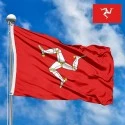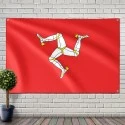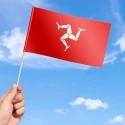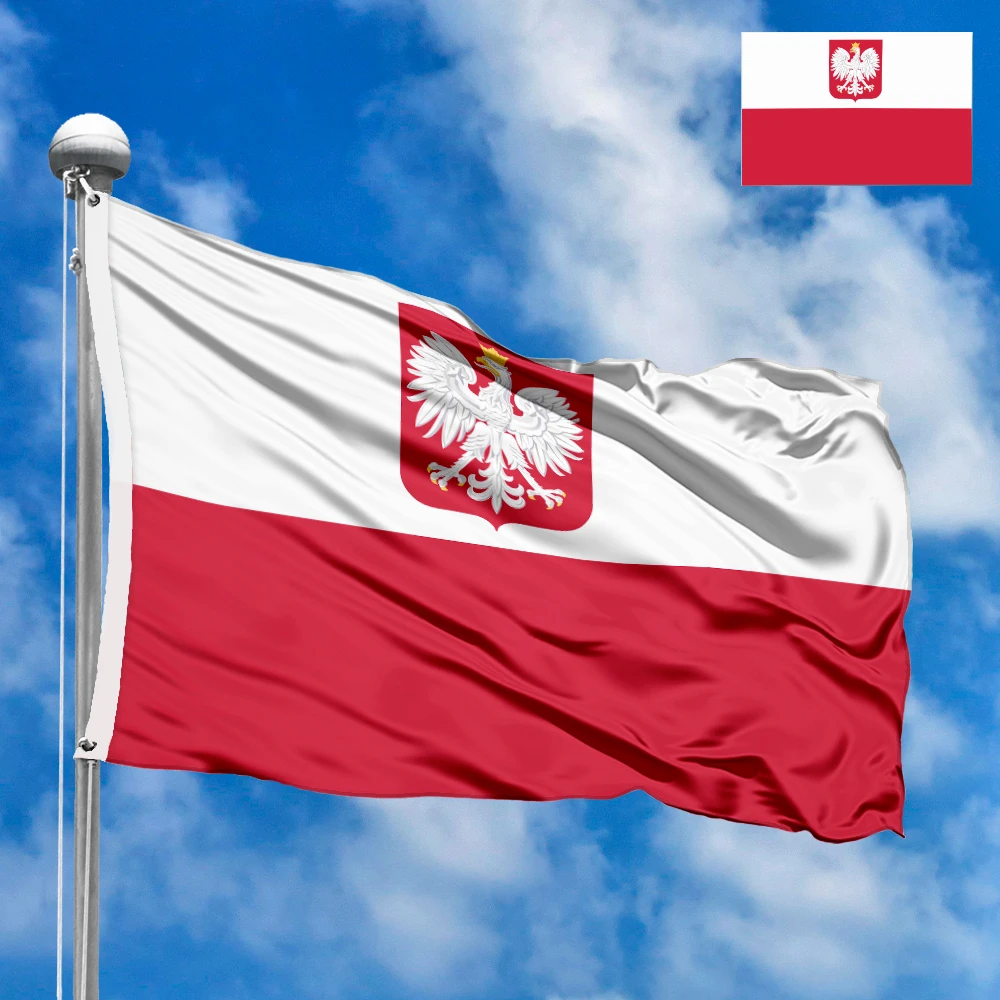The flag of the Isle of Man is one of the most unique and historically significant symbols in the world, distinctive for its unusual design. It features a bright red field with a central depiction of a triskelion (also known as a triskele) – three armoured legs, bent at the knee and joined at a central point, with golden spurs. This symbol, known in Manx Gaelic as "Ny Tree Cassyn" (The Three Legs), is much more than just an emblem; it is deeply rooted in the island's history, culture, and identity, embodying its ancient heritage, independent spirit, and resilience.
Description, Dimensions, and Arrangement of Elements
-
Main Design: The flag of the Isle of Man is a rectangular red banner with the triskelion placed centrally.
-
Triskelion Elements: The triskelion consists of three human legs, bent at the knee and conjoined at the thigh. The legs are depicted wearing knight's armour (silver or white in color) and have golden spurs. All three legs are arranged to give the impression of clockwise rotation, with one leg pointing directly downwards, ensuring visual balance.
-
Colors: The dominant color of the flag is a vibrant red (gules), often associated with bravery and strength. The legs of the triskelion are silver (white), and the spurs are gold. These contrasting colors make the symbol stand out clearly against the red background.
-
Dimensions and Proportions: The official proportions of the Isle of Man flag are typically 1:2, which is a common ratio for many flags. While physical dimensions may vary, this ratio is maintained to ensure the correct visual appearance of the flag.
History of the Flag's Creation and Symbol
The history of the Isle of Man flag is inextricably linked to the ancient triskelion symbol, which has far deeper roots than the flag itself in its current form.
-
Ancient Origins of the Triskelion: The triskelion itself is an ancient symbol dating back to prehistoric times. It has been found in various cultures worldwide, including ancient Greece, Celtic civilizations, and also in Malta and Ireland. In Celtic culture, it was often associated with movement, progress, the three aspects of life (birth, life, death), or natural elements (earth, water, sky).
-
Arrival on the Isle of Man: The exact origin of the triskelion on the Isle of Man is not definitively known, but it is believed to have been introduced to the island in the 13th century. One popular theory connects its appearance with Alexander III of Scotland, who conquered the island from the Norse in 1266. He may have replaced the Norse emblem (e.g., a ship) with the three legs of Sicily, with whose royalty he had close family connections (through his daughter's marriage). In Sicily, the triskelion (Trinacria) with the head of Medusa was used from ancient times (around 317 BC on Syracusan coins).
-
Early Use on the Island: The earliest dated use of the Three Legs on the Isle of Man is from 1310, when they appeared on the shield of Henry de Bello Monte, Governor of the Island for King Edward II of England. It is also depicted on the Manx Sword of State, which is thought to date from around 1230. From the 13th century, the triskelion became part of the coat of arms of the Lords of Mann and endured as a symbol of the island for centuries, even after the island came under English rule in 1341.
-
Official Adoption of the Flag: Despite the symbol's antiquity, the official flag of the Isle of Man in its modern design was adopted relatively recently, on December 1, 1932. Prior to this, various versions of the symbol were used on the island, as well as the Union Jack. The standardization of the triskelion's design, including the clockwise direction of the legs and one leg pointing downwards, occurred in 1966.
Country, Region, and Adoption
The Isle of Man is not part of the United Kingdom but is a Crown Dependency. This means it is a direct possession of the British Crown (His Majesty) but does not form part of the United Kingdom. The Isle of Man has a high degree of self-governance in its internal affairs, while the UK is responsible for its defense and foreign policy.
The flag of the Isle of Man is officially recognized and used by the Isle of Man Government, its institutions, and its population. It is approved as a civil and state flag. Additionally, there is a Manx Red Ensign (also known as a "defaced Red Ensign"), which is a red flag with the Union Jack in the canton (upper hoist quarter) and the triskelion towards the fly. This ensign is flown by ships registered in the Isle of Man.
Significance for Residents
For the residents of the Isle of Man, the triskelion on the flag holds deep and multifaceted significance:
-
Symbol of Resilience and Independence: The most famous meaning of the triskelion is linked to the island's Latin motto: "Quocunque Jeceris Stabit" (Whichever way you throw it, it will stand / Wherever you cast it, it will stand). This motto, first recorded on the island around 1300, perfectly reflects the symbol of the three legs that always "land on their feet," no matter how they are thrown. For Manx people, this is a powerful symbol of their resilience, their ability to overcome challenges, and their determination to preserve their identity and independence despite historical challenges and external influences.
-
Identity and Heritage: The flag is the quintessential representation of Manx identity. It represents the unique Manx language (a critically endangered but reviving Gaelic language), its Celtic-Norse heritage, and the island's distinct culture. It unites residents around their common history and distinctiveness.
-
Connection to Nature and Paganism: Some interpretations of the symbol connect it to ancient pagan beliefs, symbolizing the sun, movement, or natural elements (earth, air, water). This alludes to the deep connection of the Manx people with their environment and ancient traditions.
-
Pride and Belonging: The triskelion flag is a source of pride for the island's residents. It can be seen on public buildings, private homes, during national holidays, and at sporting events, expressing a strong sense of belonging to the Isle of Man.
-
History of Parliament: The Isle of Man prides itself on its parliament, Tynwald, which is considered the oldest continuously sitting parliament in the world (dating back to 979 AD). The triskelion is an important symbol of Tynwald, emphasizing the antiquity and continuity of Manx self-governance.
Interesting Facts
-
One of the Oldest Symbols: Although the flag itself was adopted in 1932, the triskelion on it is one of the oldest symbols still in use as a state or regional emblem.
-
Connection to Sicily: One of the most striking resemblances of the Isle of Man's triskelion to Sicily's symbol (Trinacria) highlights possible historical links, likely through the Vikings who sailed the Mediterranean and were familiar with Sicily. The difference is that the Sicilian trinacria often includes the head of Medusa in the center, and the legs are typically bare.
-
Manx Cats (Tailless Cats): The Isle of Man is not only famous for its flag but also for its unique breed of cats – Manx cats, which are born without tails due to a natural genetic mutation.
-
Tourist Trophy (TT) Races: The Isle of Man is world-renowned as the host of the Isle of Man TT motorcycle races, one of the oldest and most dangerous road races in the world. The flag is often used in the symbolism of these competitions.
-
Tynwald Day: Annually on July 5th, Tynwald Day, the national holiday of the Isle of Man, is celebrated. On this day, laws passed by Tynwald are publicly proclaimed in both English and Manx, a unique tradition that underscores the island's independent status. The flag is widely displayed during this celebration.
-
Lord of Mann: The British monarch holds the title "Lord of Mann." Even if the monarch is a woman (like Queen Elizabeth II), she retains the title "Lord," not "Lady."
In the demonstration images, full-size flags are shown with proportions of 2:3, and hand-held flags with proportions of 1:2.







 Waving flag
Waving flag
 Sizes:
Sizes:
 Round flag
Round flag
 Sizes:
Sizes:
 Rectangular flag 2:3
Rectangular flag 2:3
 Sizes:
Sizes: